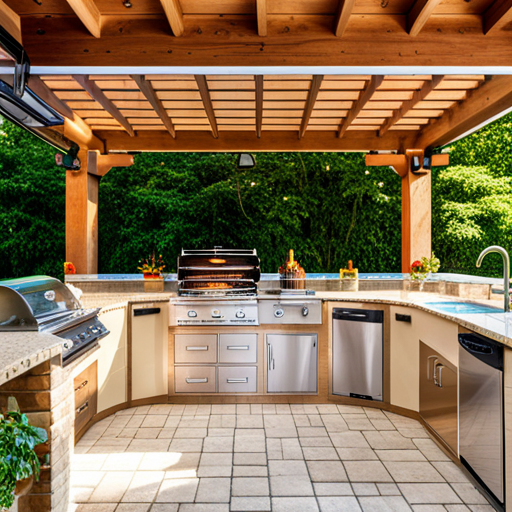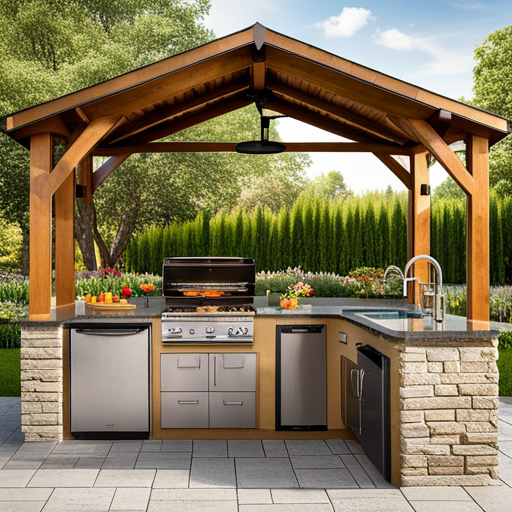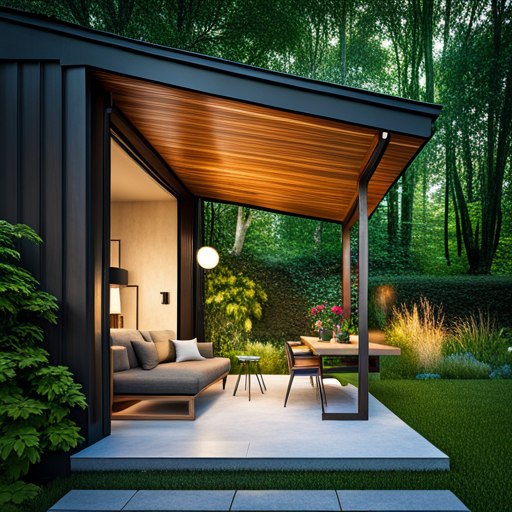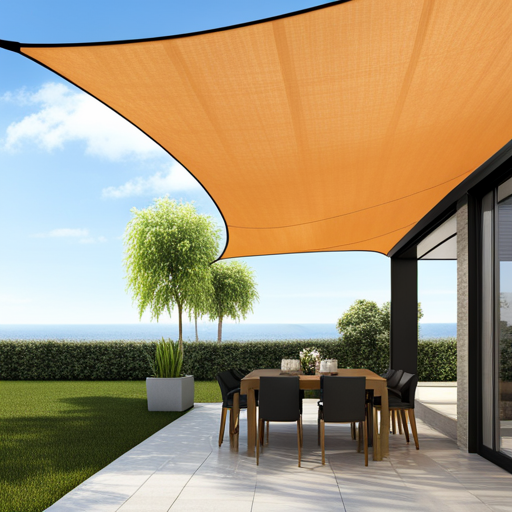Last Updated on May 29, 2024 by John Coleman
Choosing the perfect grill for your outdoor kitchen is a very important decision to make. There are so many options to choose from and you want to make the best decision. How do you choose a grill for your outdoor kitchen?
This list of items will guide you in choosing the right grill for your outdoor kitchen:
- Type of grill desired
- Grill size and cooking area that will suit your needs
- Adequate BTUs (100 BTUs per square inch of cooking surface)
- Brand standard of quality, durability, and warranty
- Additional features available at the time of purchase or that can be added in the future
- Difficulty level of cleaning and maintenance
- Safety features
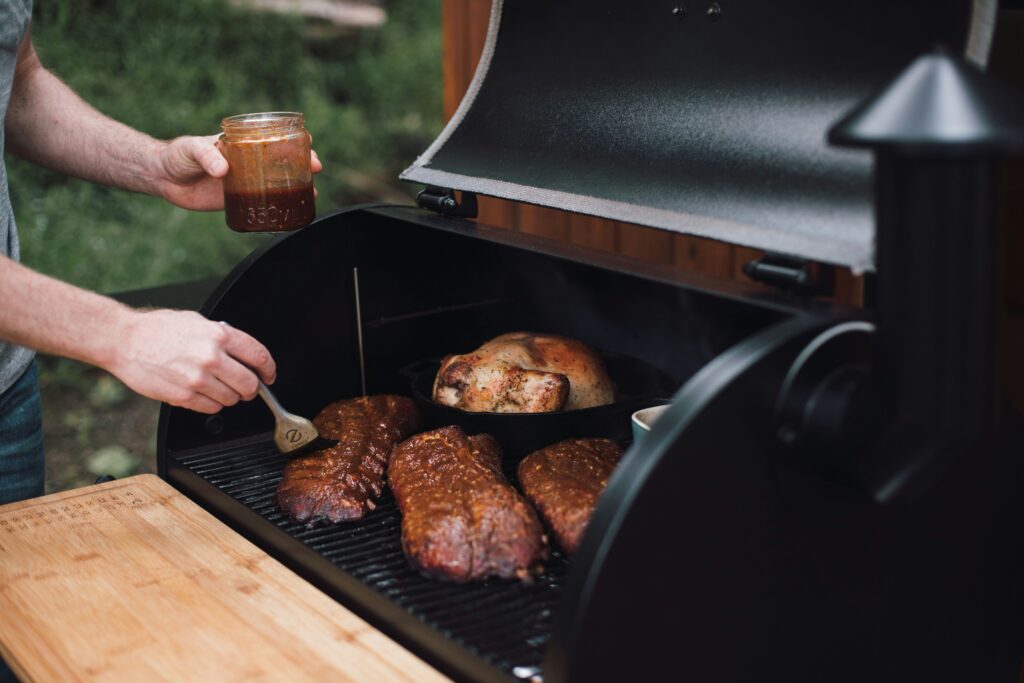
Introduction
Gatherings with family typically unfold in the backyard, around the pool, on the patio, or under the shelter of your outdoor kitchen. These get-togethers might be for basking in the sunshine or congregating for the big game. Attendees at these events inevitably gather around the grill for socialization. This underscores the significance of selecting the ideal grill for your outdoor kitchen. Owning the perfect grill for an outdoor kitchen ensures efficiency in food preparation and delivers the flavors everyone anticipates. To simplify your decision-making process, I have compiled crucial information to consider as you select the heart of your outdoor space. I hope your search is successful and you find exactly what you need!
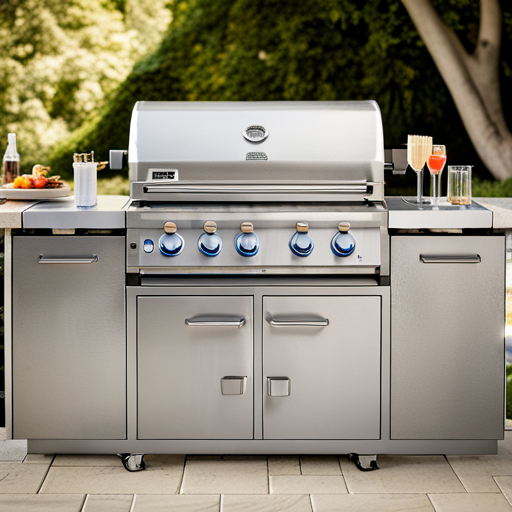
What to Consider When Buying a Grill for Your Outdoor Kitchen?
As you embark on your search for the perfect outdoor grill, there are several crucial factors to keep in mind. These considerations will help guide you toward making an informed decision that meets your specific needs and preferences. Let’s take a closer look at these factors:
Charcoal/Wood-fired Grill
This is the traditional grill that most people use when grilling outdoors. It uses charcoal
as a primary heat source. While this is a great option for reaching high temperatures and producing the smokey flavor most love, it has drawbacks. One must be able to endure the significant amount of smoke that a charcoal grill produces as well as the smokey smell that goes along with it. It would likely not be an ideal choice for anyone who prefers not to smell like smoke or suffers from breathing issues.
Wood grilling can be accomplished with a standard charcoal grill. The cool thing about this type of grilling is that you can use popular species of grilling wood such as hickory or cherry that you have hand-cut yourself which lowers your costs of fuel tremendously. However, if you are not into going out and cutting your own fuel, you can always buy various flavored wood chips to suit your taste. Trust me, there are some good flavored ones on the market including bourbon barrel, apricot, and pear.
If you purchase through links on this site, we may earn a small commission. See our affiliate disclosure.
Gas Grills
Gas grills have become the go-to grill for those wishing to move away from charcoal. These grills are easy to use with regard to temperature control and quick heating time. They will not produce the smokey flavor provided by charcoal but that can be made up with adequate seasoning (perhaps even add “liquid smoke” to your marinade to produce the smokey flavor effect). Due to gas grills running off natural gas or propane, you have to plan ahead to make sure you have enough fuel in reserve to prevent running out halfway through your grilling session.
Pellet Grills
Pellet grills have taken the market by storm. Pellet grills are usually electric and use wood pellets as a fuel source. The wood pellets come in various flavors such as apple, mesquite, BBQ, cherry, and hickory which accommodate various cooking styles and taste preferences. These grills are a great option when temperature control is a priority. If you choose to go with a pellet grill, it is important to remember that you need to have an electrical outlet near where you are going to use it. Also, the wood pellets (depending on the kind you prefer) can be more expensive than other fuels.
(For a list of the Best Pellet Grills, Click Here)
Electric Grills
Electric grills are very convenient for areas that have open flame restrictions. They are great for use in small spaces and do not produce an overwhelming amount of smoke. Some may say that electric grills don’t produce enough flavor but again, I think that it is all about the marinade and seasoning.
Hybrid Grills
You can get the best of combined worlds with hybrid grills which can have multiple fuel sources such as gas and charcoal all in one unit. You can choose to use one fuel at a time or both fuels at once; depending on what type of food you are grilling. Keep in mind that this option is going to double the fuel costs as you will have to buy more than one type of fuel.
Infrared Grills
The infrared-style grill uses an infrared heating element as the heat source. Though they are not a common option, they have their place in the grilling world. They can achieve quick cooking times but have limited capabilities with regard to temperature control. Cooking on these grills is quite different from the other options mentioned in this list.
What Grill Size and Cooking Area to Choose?
When it comes to grills, size really matters. Before you buy one, think about how much space you have for storage and cooking. Small grills work great if you don’t have much outdoor space or only grill occasionally. But if you’re into throwing big parties or cooking for a large family on the regular, a bigger grill might be more your style. Also, make sure to check the cooking area of the grill. That’ll tell you how much food you can cook at once, which is super important if you love having people over.
How many BTUs Does a Good Grill Have?
BTUs (British thermal units) are often used to measure the heat output of a grill. However, it’s important to note that a higher BTU does not necessarily translate to better cooking results. The quality and distribution of heat are crucial in determining how well your food gets cooked. A good rule of thumb is that for every square inch of cooking surface, you’ll want about 100 BTUs. This means a grill with 500 square inches of cooking area should have at least 50,000 BTUs for optimal heat distribution.
What Standards of Quality and Durability Should I Focus On?
It’s important to invest in a grill that will last for years to come. But how can you tell if a grill is of good quality and durability? Here are some signs to look out for:
- Material: Grills made with high-quality materials, such as stainless steel or cast iron, tend to be more durable and long-lasting. These materials are also easier to clean and maintain.
- Construction: A well-constructed grill will have solid and sturdy joints, without any loose parts or wobbling.
- Warranty: A reputable brand will offer a warranty for their grills, giving you peace of mind in case anything goes wrong.
Overall, it’s important to do your research and read reviews before making a decision. A quality grill may cost more upfront, but it will save you money in the long run by lasting longer and providing a better cooking experience.
What Additional Features are Beneficial?
Aside from size and cooking area, other features can enhance your grilling experience. Some common additional features include:
- Side burners: These are great for cooking side dishes or sauces while grilling your main course.
- Rotisserie: A rotisserie attachment allows you to cook large cuts of meat evenly and slowly, giving them a delicious flavor.
- Smoker box: If you enjoy smoked meats and vegetables, a smoker box attachment can add that extra touch to your grilling.
- Temperature gauge: A built-in temperature gauge can help you monitor and control the heat of your grill, ensuring perfectly cooked food every time.
- Storage shelves/cabinets: Having extra storage on your grill can be convenient for keeping utensils, seasonings, and other grilling tools nearby.
- LED lights: For those who enjoy grilling at night, LED lights can illuminate the cooking area and make it easier to see your food. You can also buy attachable lights which can reduce the cost of lights that are installed inside the grill.
- Removable ash pan: This feature makes cleaning up after a barbecue much easier and less messy.
- Warming Racks: Some grills come with an additional warming rack, which can be useful for keeping food warm while you finish cooking other items.
- Bluetooth connectivity: For the tech-savvy grillers, some models offer Bluetooth connectivity which allows you to monitor and control your grill from your phone.
- Multiple fuel options: Some grills offer the option to use charcoal, propane, or natural gas, providing versatility in your cooking methods.
- Easy assembly: Look for grills that are easy to assemble, especially if you plan on moving or storing them frequently.
Before purchasing additional features, consider your grilling preferences and the type of food you enjoy cooking. If you prefer simple grilling, a basic grill may suffice. However, if you enjoy experimenting with different techniques and flavors, investing in additional features can elevate your grilling experience. Also, consider the size and layout of your outdoor space. Limited storage? Opt for a grill with built-in shelves or cabinets. Ultimately, finding the right combination of features will enhance your grilling experience. Take your time and carefully consider all factors.
What is the Price Range of a Grill for an Outdoor Kitchen?
The price of a grill for an outdoor kitchen can vary greatly depending on the brand, size, and features. Basic models can start at around $200, while high-end grills with all the bells and whistles can cost upwards of $4000 or more. Typically, larger grills with more features will be more expensive. It’s important to set a budget before purchasing and prioritize which features are most important to you. Remember, a higher price does not always guarantee better quality. Do your research, focus on the features that are most important to you, and then read reviews to find the best value for your money.
Maintenance and Cleaning Tips for Your Grill
A well-maintained grill can last for many years and provide delicious meals for countless backyard gatherings. Here are some tips to help keep your grill in top condition:
- Regularly clean the grates with a wire brush or other cleaning tools after each use to remove food debris and prevent buildup.
- Cover your grill when not in use with a heavy-duty grill cover to protect it from the elements. This will also prevent rust and extend the life of your grill.
- Check for gas leaks by applying a soapy water mixture to the propane tank, hoses, and connections. If bubbles form, there is a leak that needs to be addressed before using the grill again.
- Clean the interior of your grill every few months with warm water and soap or a specialized grill cleaning solution. Be sure to also clean the drip tray and remove any ash or debris from the bottom of the grill.
- Inspect and replace any worn-out parts, such as burners or igniters, as needed to ensure proper functioning.
By following these maintenance and cleaning tips, you can keep your grill in top shape for many years to come.
What Safety Features To Look For?
Grills can pose potential safety hazards if not used properly. Here are some important safety features to consider when purchasing a grill:
- An automatic shut-off valve: This feature will automatically cut off the gas supply if the flame accidentally goes out, preventing any possible gas leaks and potential fire hazards.
- A built-in thermometer: Having a temperature gauge on your grill can help prevent overcooking or undercooking food, reducing the risk of foodborne illnesses.
- Sturdy construction: Look for grills made with durable materials and stable legs to prevent tip-overs or other accidents.
- A grease management system: Excess grease buildup can cause flare-ups, which can be dangerous. A grill with a built-in grease management system will help reduce the risk of flare-ups and keep your grill clean.
Safety features are important because they provide an extra layer of protection and help prevent accidents. However, it’s also crucial to use your grill responsibly and follow proper safety precautions, such as keeping it away from flammable materials and never leaving the grill unattended while in use.
Conclusion
To sum it up, choosing a grill for your outdoor kitchen needs some careful thinking. You should consider things like size, type, durability, maintenance, and safety. Each of these factors is super important for a top-notch grilling experience. If you overlook any of them, you might end up with subpar cooking results, safety risks, or extra maintenance headaches. So, it’s crucial to fully understand these factors before making a purchase. When you take all of ’em into account, you’ll find a grill that not only fits your cooking preferences but also ensures safety, easy maintenance, and long-lasting performance. It’s gonna level up your outdoor cooking game, my friend! So, don’t forget to do your research and choose wisely.
If you purchase through links on this site, we may earn a small commission. See our affiliate disclosure.
Frequently Asked Questions
What is the best type of grill for beginners?
For beginners, a gas grill is often recommended. They’re easy to use, heat up quickly, and allow for precise temperature control.
Is it worth it to buy an expensive grill?
It depends on your personal preferences and needs. Expensive grills often have better quality materials and advanced features, but a mid-range grill can also provide satisfactory results.
Is black or stainless steel better for a grill?
Stainless steel is more durable and easier to clean than black grills. However, black grills are often cheaper and can still provide good cooking results.
What is the most common size grill?
The most common size for a grill is around 500 square inches, which can comfortably cook for a family of four.
What grills are easiest to use?
Gas grills are generally considered the easiest to use, followed by electric and charcoal grills. Pellet grills also offer ease of use with temperature control settings.
Is it necessary to have a grill with a grease management system?
Yes, it’s highly recommended. A grill with a grease management system helps prevent dangerous flare-ups and keeps your grill clean, making it easier to maintain.
What safety precautions should I take when using a grill?
Always keep your grill at a safe distance from flammable materials, never leave it unattended when in use, and ensure to turn off the gas supply when finished.
How do I maintain the longevity of my grill?
Regular cleaning, proper storage during off-seasons, and using a grill cover to protect it from the elements can help maintain the longevity of your grill.


